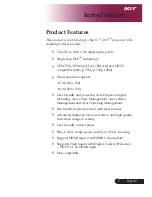
7
Symptom
Cause
Solution
Screen will not move “up.”
Motor does not hum.
Motor hums.
No power between red and white leads in
junction box.
Check LVC. See above.
Check fuse. Reset circuit breaker. Correct
improper wiring.
Thermal overload tripped (acts as a breaker).
Let motor cool for 15 minutes. Try again.
Burned out motor winding.
Check for power between red and white motor leads.
Replace motor if there is power.
Temporary fabric binding.
With power “off,” turn roller by hand to free binding.
Burned out capacitor.
Replace capacitor.
Broken wire or loose connection in “up”
position (red and white leads).
Secure connection or replace wire.
Screen starts upward and door closes
immediately shutting off motor.
Defective solenoid limit switch.
Solenoid pin not retracting.
Manually retract pin a few times..
Defective solenoid.
Check for power to the solenoid terminals. If there is
power, replace solenoid.
Check blue wire between solenoid switch and solenoid.
It is either crimped or broken. Repair or replace.
Fabric door does not fully open.
Screen runs.
NOTE: Remember, door must
open by gravity.
Door binding. Plaster, paint or adhesive can
cause the hinge to stick.
Clean hinge and apply oil.
Case may be put into a bind during installation.
Tighten or loosen lag screws located on back of case.
Inadequate clearance around the fabric door
on new installations.
Provide adequate clearance.
Clicking noise in each downward
revolution.
Non-energized solenoid.
NOTE: There should be three clicks.
Check for power to solenoid.
Replace solenoid.
Loud buzzing noise.
Solenoid not fully retracting.
Check for foreign object caught in solenoid. Remove
object. Tighten 4 mounting screws.
Check for pin binding.
Door closes on fabric, leaving 15" to
20" left hanging out.
Lost roller wrap.
See installation instructions.
Troubleshooting
Summary of Contents for ExecutiveElectrol
Page 1: ...INSTRUCTION BOOK FOR Executive Electrol...
Page 9: ...9...
Page 10: ...10...
Page 11: ...11...






























